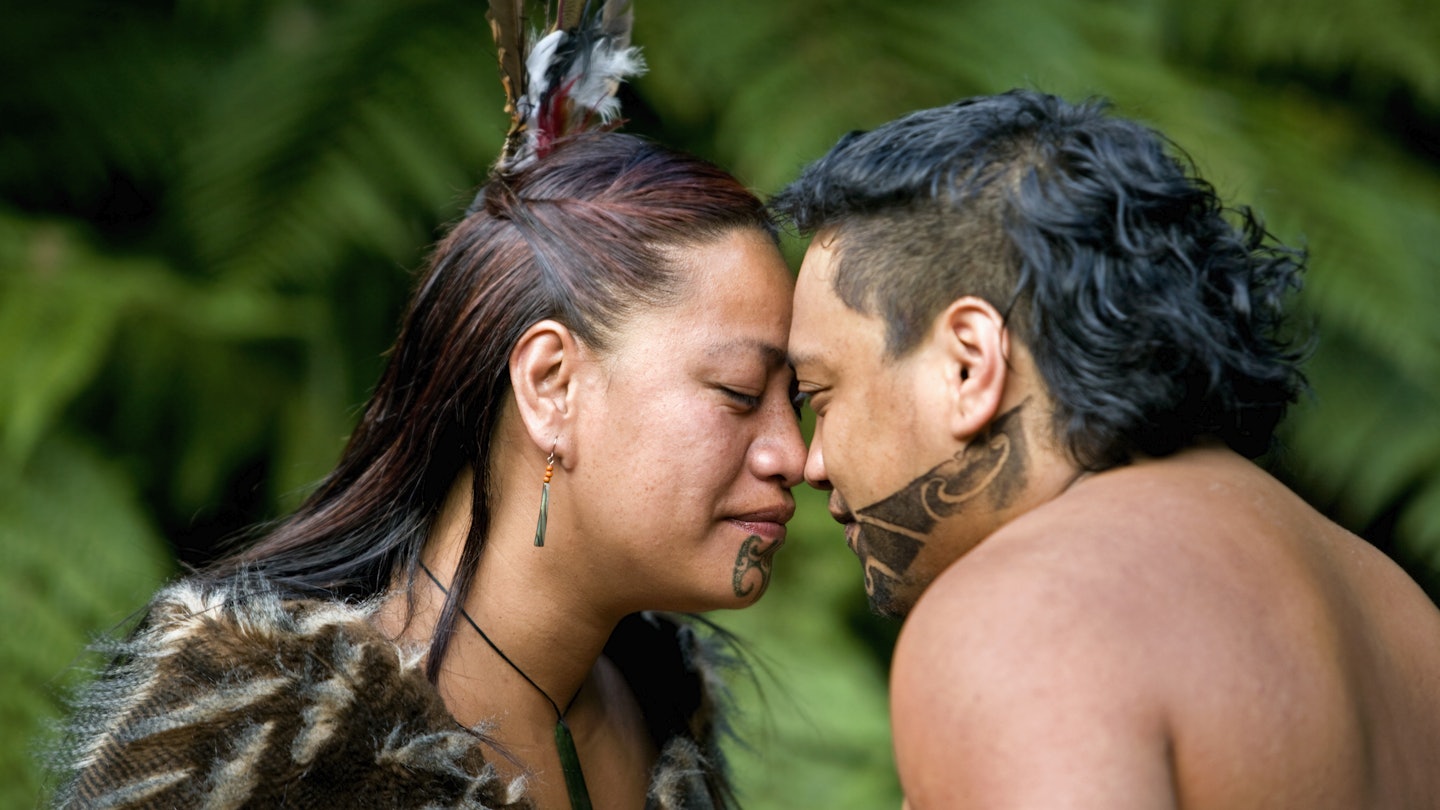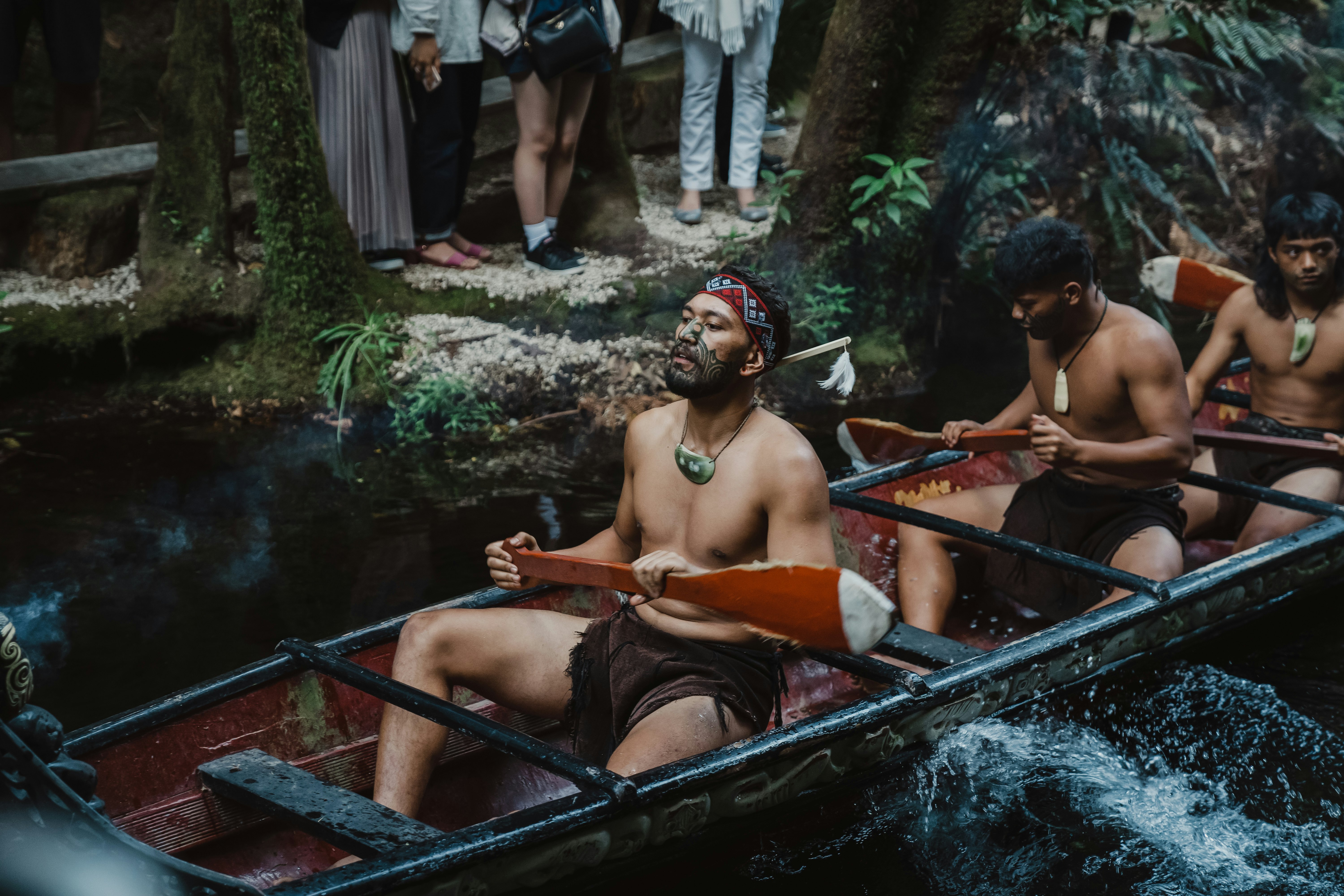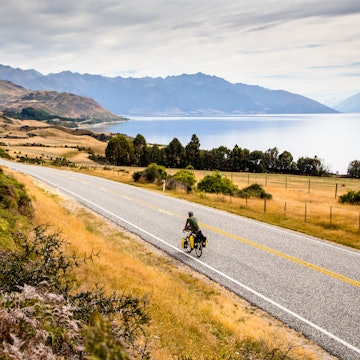

The greeting known as the hongi is just one tradition you'll discover on a Māori tour of New Zealand. Frans Lemmens/Getty Images
Visitors to New Zealand often don't know much about the Māori, the Indigenous population of these islands, beyond having seen the haka (war dance) performed by the All Blacks rugby team. But we are an entrepreneurial people, who have shared our beautiful culture through tourism for nearly two centuries.
My ancestors were some of the first tour guides in the Bay of Plenty’s geothermal fields in the mid-1800s, and now it's my turn to share some of the best spots in Aotearoa (New Zealand’s name in the Māori language) with you, so you can add some Māori experiences to your list of things to do.
A remarkable range of landscapes and experiences can be found in our small nation, offering something for every traveler and every budget. While the earliest forms of Māori tourism primarily showcased natural wonders such as Rotorua’s geysers, contemporary operators offer diverse experiences to pique your interest – from enjoying a hāngī (earth oven) meal while watching a cultural performance to paddling across New Zealand’s beautiful waters in a traditional waka (canoe).

Where is the best place to experience Māori culture in New Zealand?
You’ll be surrounded by opportunities to immerse yourself in te ao Māori (Māori culture) from the moment you arrive in New Zealand. I mean that literally – visitors arriving at Auckland's International Airport are beckoned in with the greeting "Nau mai, haere mai" ("welcome") as they enter through a traditional waharoa (carved Māori gateway).
However, the experiences on offer vary depending on the area you visit. The vast majority (85%) of the country’s nearly one million Māori live on Te-Ika-a-Maui (the North Island), and around one-third of the population of regions such as the Bay of Plenty, Hawke’s Bay and Northland are Indigenous. Likewise, the majority of people in Gisborne Tairāwhiti are Māori, making this another good place to experience te ao Māori.
The two most famous places to learn about Māori culture are both on the North Island. In Northland, the Waitangi Treaty Grounds mark the site where Māori chiefs and British representatives signed a treaty to establish the bicultural nation of New Zealand in 1840. South of Auckland is the geothermally active town of Rotorua, the setting for many Indigenous encounters, including trips to Whakarewarewa, home of the Tūhourangi Ngāti Wāhiao people, who have been hosting visitors in their traditional village for over 200 years.
Despite its smaller Māori population, the South Island also offers opportunities to learn about Māori culture. The island is known to Māori as Te Wapiounamu ("The Greenstone Waters") as this is the country’s main source of pounamu (jade, or greenstone), used to make decorative objects, jewelry, tools and weapons. Joining a greenstone-carving workshop or taking a guided tour to find pounamu with a local Māori guide in Hokitika are two rewarding ways to connect with our culture.

Where can I see a Māori cultural show?
Across Aotearoa, tourists can attend cultural performances showcasing kapa haka (performing arts), with shows catering to a range of budgets. These are most easily found on the North Island and typically include a display of haka, waiata (songs), waiata-ā-ringa (action songs) and moteatea (chants) exploring ancestral narratives.
At sites such as the Waitangi Treaty Grounds and the Auckland Museum, short performances are included as part of the adult entry passes. For the more historically inclined, the multi-sensory show at Manea Footprints of Kupe on Northland’s magical Hokianga Harbour beautifully explains local narratives about the discovery of Aotearoa by Polynesian explorers)
In Rotorua, the birthplace of Māori tourism, half and full-day cultural experiences abound. Te Puia offers several different shows; some shows even include a buffet meal prepared in the traditional Māori hāngī style – cooked in earth ovens or using geothermally heated water. You don't have to book a show to enjoy hāngī-style food at Te Puia's striking restaurant, Pātaka Kai, where floor-to-ceiling windows offer views of the Pōhutu Geyser.
Longstanding, family-run Mitai Māori Village also offers a recreated pā in a beautiful setting, a pōwhiri and cultural performance, and a genuine earth-cooked hāngī. You'll also get to see a waka (canoe) in action. Te Pā Tū begins with a visit to a recreated pre-colonial pā (fortified village) in a bushland setting. What follows is a mixture of the traditional and modern, with a pōwhiri and performances, plus a contemporary take on Māori cuisine.
Only an hour north of Auckland, Te Hana Te Ao Marama Cultural Centre also offers cultural performances.
If you're interested in Māori performing arts, time your trip to coincide with Te Matatini, the "Olympics of kapa haka." The next biannual Te Matatini will take place in 2027, so keep an eye on the Te Matatini website and social media for details of the dates and location for the next event which is growing in size and popularity.

Are there more ways to experience Māori culture in New Zealand?
Māori are not one unified people. Instead, think of our iwi (tribes) and hapū (subtribes) as being more like independent city-states, with practices and traditions varying across the country. For this reason, it’s worth experiencing what several Māori tourism operators have to offer.
While watching kapa haka or eating hāngī may be especially memorable, there are many other ways to engage with te ao Māori on your holiday. Here are just a handful.
Visit a site of historical or cultural significance
Northland isn’t just the birthplace of modern New Zealand, it’s also where many of the first Polynesians settled in Aotearoa, laying the foundations for Māori society. The area is rich with sites reflecting this long history. Rangihoua Bay in the Bay of Islands is the first place where Māori and European families coexisted; it’s free to visit and a good place to learn about early Pākehā (non-Māori) settlement.
Cape Reinga, near the country’s northernmost tip, is where the Pacific Ocean and Tasman Sea meet – and where some Māori believe spirits depart for the afterlife. While you’re in Northland, take a detour through Waipoua Forest to view Tāne Mahuta – a giant, 2000-year-old kauri tree, named after the forest god Tāne Mahuta because of its strength and stature. While it's free to visit, insightful guided tours can be booked through Footprints Waipoua.
Finally, round out your trip to the region with a stop at Ruapekapeka, Northland’s most formidable pā (fortified village) at the time of the British conquest. Today, the remains of this impressive earthwork fortress are free to visit. You don’t have to leave Auckland to discover Māori heritage; in the city’s Ōtuataua Stonefields, you’ll find an ancient Māori garden that includes the archaeological remains of a historic kainga (village).

Attend a Māori cultural festival
It doesn’t matter what time of year you visit – there’s always something going on in New Zealand. Summertime visitors should set their sights on the bi-annual Tāmaki Herenga Waka Festival, held over the Auckland Anniversary weekend at the end of January. Celebrations include the opportunity to sail a traditional Māori boat across Auckland’s Waitematā Harbour.
Also in Auckland is the ASB Polyfest, showcasing the best Māori and Pasifika performances by school-aged children. The MāoriLand Film Festival promotes new Māori films every March in the small town of Ōtaki, near Wellington.
One of the biggest events of the year is February’s Waitangi Day, commemorating the anniversary of the signing of the Treaty of Waitangi. This public holiday is celebrated with events across the country, including at the Treaty grounds in the Bay of Islands.

Sample traditional and contemporary Māori cuisine
Set in South Auckland, the Hāngī Shop sells some of the islands' most authentic kai (Māori food). However, Māori cuisine isn’t limited to hāngī – here are a few spots to track down other local favorites:
Head to Auckland's Pasifika cafes such as Blue Rose or Tupu’anga for a hāngī pie.
Try Kingi in Auckland for local kaimoana (seafood).
George’s is New Plymouth’s best spot for "boil-up" – a Māori soup with a pork-bone base, served with fried bread.
Hit Karaka Cafe in Wellington for a contemporary and fusion Māori kai fix; it's set on the capital’s wonderful waterfront.
In the sunny South Island town of Nelson, you’ll find similar Māori cooking at Kiwi Kai.

Experience the night sky through Māori eyes
If you arrive in Auckland during the Māori new year in June or July, visit the Matariki astronomy show at the Stardome observatory. Matariki is one of three constellations that signifies the coming of the new year, and plenty of epic events and fantastic festivals are held across Aotearoa at this time.
Year-round, Māori astronomy is explained at Tekapo’s Dark Sky Project on the South Island, widely considered one of the world’s best stargazing spots because of the absence of light pollution.
Get out into the bush or onto the water with a Māori-led tour
A deep connection to the surrounding environment is key to Māori culture, and outdoor adventures are a great way to learn more about our culture. You can take a guided hike with the Māori-owned Kaitiaki Adventures up 1111m Mount Tarawera, which violently erupted in 1886, destroying several nearby villages. Or, if you’re a thrill seeker, the same operator offers whitewater rafting in Rotorua down the Kaituna, Rangitaiki or Wairoa rivers.
There are also opportunities to paddle in a waka (Māori-style canoe). Waka Abel Tasman lets you glide across the pristine seas of a national park at the top of Te Waipounamu, with journeys starting at Kaiteriteri. Or, you can spend two hours rowing a traditional waka down Wellington’s waterfront with Te Wharewaka o Poneke.
Visit a New Zealand museum
Auckland’s War Memorial Museum has a fantastic Māori court that includes Hotunui, a magnificent carved meeting house, and Te-Toki-a-Tāpiri, the last surviving great war canoe (Te Rā, the last known seafaring sail, is on loan to the museum until August 2025). The Museum of New Zealand Te Papa Tongarewa is a must-visit in Wellington to discover Māori artifacts, exhibitions and stories – the Karetao-puoro Māori instruments exhibit is particularly memorable.
Te Rau Aroha at the Waitangi Treaty grounds, gives visitors an in-depth understanding of the contribution made by Māori fighting for the British Empire during the Great Wars, while the Whanganui Regional Museum has great displays and exhibitions in the small town of Whanganui.

How can I visit a Māori community and what can I expect when I visit a marae?
The hubs of Māori communities are marae – ceremonial complexes centered around wharenui (carved meeting houses). They’re sacred sites, so you can’t just waltz onto a marae uninvited. However, if you’re eager to learn more about Māori culture, some marae (including those at Whakarewarewa in Rotorua and Te Hana just north of Auckland) offer guided tours to welcome visitors in a tika (culturally appropriate) way.
As you approach the marae, your hosts will explain what you should expect, including the steps for the pōwhiri (welcome ceremony) process. Pōwhiri begin with a melodic call from the tāngata whenua (hosts) and a response from the manuhiri (visitors), followed by karakia (blessings), waiata (songs) and whaikōrero (oratory). During this ceremony – which is undertaken in te reo Māori (the Māori language) – men and women are separated, with women entering at the front of the procession but sitting in the back, while men follow behind to enter but sit at the front.
After the ceremony, you may be invited into the wharenui. Before you step inside, it’s important to keep cultural protocol in mind. Take off your shoes and turn off your phone before heading indoors, and only take photos inside the wharenui if you have permission to do so. If food or drink is served at a marae, it should only be consumed after a blessing and shouldn’t be taken inside the wharenui. Finally, don’t sit on tables in the marae or anywhere else for that matter – it’s considered offensive.

How else can I demonstrate respect towards the Māori culture and people?
Māori view the natural environment of Aotearoa as living ancestral deities, so we expect visitors to treat nature with respect. For best practices on how to help preserve and protect the country’s environment, culture and people as a tourist, read up on the Tiaki Promise.
Another way to demonstrate respect towards our unique culture is to learn some of our reo (language). We Māori consider te reo Māori to be our foremost cultural treasure, and learning some simple words and phrases will bring a smile to the faces of Māori you meet during your visit. As a general rule of thumb, our language is pronounced with soft vowel sounds, similar to Romance languages, but we like to roll our Rs and words tend to flow together without noticeable gaps between them.
The most common way to say hello is "kia ora," which is also a way to say thank you. However, in the morning you’d say "mōrena" or "ata mārie" to greet someone. To say “goodbye,” you could say "mā te wā" ("see you later"). However, when you leave Aotearoa, we hope you’ll say "ka kite anō" ("see you again") instead, as we love to host our visitors time and time again.









![Manukau Heads Lighthouse, Auckland, New Zealand [closeup view] License Type: media Download Time: 2022-02-25T15:39:58.000Z User: bhealy950 Is Editorial: No purchase_order:](https://lp-cms-production.imgix.net/2025-10/Shutterstock1352692988.jpg?auto=format,compress&q=72&fit=crop&w=360&ar=1:1)






